Fix: The device is being used by another application (HDMI)
HDMI stands for High-Definition Multimedia Interface. You can get a pretty good idea of what the HDMI is used for just from the name of it. An HDMI is used to connect multimedia interfaces. People generally use HDMI cables to connect TVs to their computers. HDMI cables can be used to connect other devices too but you get the point. It provides a very handy way to watch your media on other big screens or devices. But, you might face the issue of “no sound” while connecting the HDMI cable. You might also see an error message saying
“The device is being used by another application. Please close any devices that are playing audio to this device and then try again”
This problem can be caused by a few things. The first thing is a faulty driver. In fact, a lot of cases were solved by rolling back to a previous driver. In other cases, updating the drivers solved the issue as well. Another reason might simply be the one presented in the error message i.e. caused by another application using the audio device.
But, no matter what is causing this issue, it can be solved within a few minutes. There are a few things that can be done to rectify this problem. Simply follow the methods given below.
Tip
Before doing anything else, you might want to use the built-in troubleshooter that Microsoft provides. It might solve the issue. It doesn’t take a lot of time so there’s no harm in trying. Here are the steps to troubleshooting your sound problem
- Hold Windows key and press R
- Type control.exe /name Microsoft.Troubleshooting and press Enter
- Click Hardware and Sound
- Click Playing Audio
- Click Next
- Wait for it to scan. It will ask you to select the device that is causing the issue. So select the one that needs troubleshooting and click Next
- Now follow any additional on-screen instructions. If there are any settings that can be changed then the troubleshooter will pin point those settings.
Method 1: Allow applications to take exclusive control Option
If you are seeing this error message then the first thing that you should do is to do what the error message is telling you. The error message clearly tells you that the device is being used by another application. So, simply closing other applications that might be using sound and turning off the option that allows other applications to take control of your device should solve the issue. And, it actually does solve the problem for a lot of users.
First, you need to look at the applications that are using the audio device. Next, you need to close those applications. Lastly, you should turn off the option that allows other application to take control of the device. So, here are the steps for doing all of these tasks
- Hold Windows key and press R
- Type sndvol and press Enter
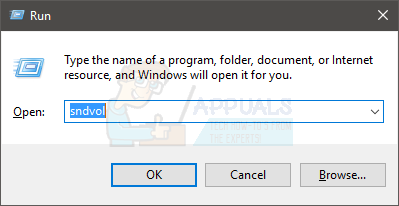
- This will show you the applications that are using the audio device. You should close these applications. Note: If you don’t see any devices here then skip this step and go to the next step. Press CTRL, SHIFT and Esc simultaneously (CTRL + SHIFT + ESC) to open the task manager. Now, select the applications that are using the audio device and click End Task. Repeat this End Task step for all the applications that were using the audio device

- Right click on the speaker icon at the bottom right corner and select Playback Devices

- Select the audio device, right click and select Note: In the screenshot, I am selecting my default audio device. You should select the device that has the no sound issue.

- Click Advanced tab
- Uncheck the option that says Allow applications to take exclusive control of this device.
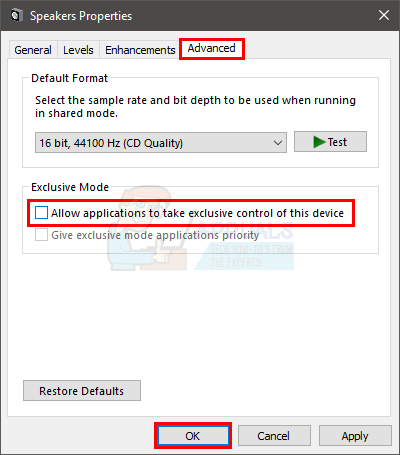
- Click Ok
- Restart your system
Now, check if the problem is solved or not.
Method 2: Restart Audio Service
Sometimes, simply restarting the Audio Service of the Windows will solve the issue for you.
- Hold Windows key and press R
- Type services.msc and press Enter

- Locate and double click Windows Audio
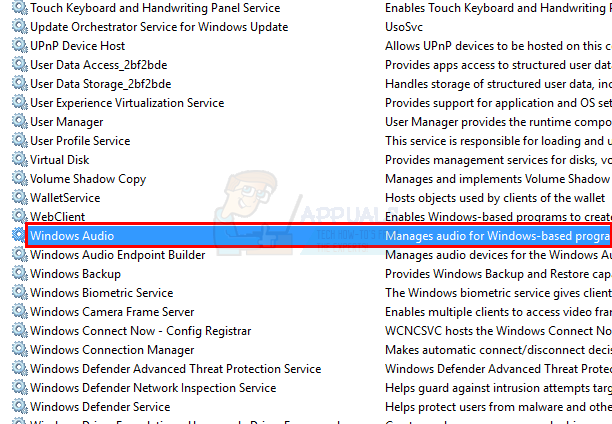
- Click Stop in the Service Status section
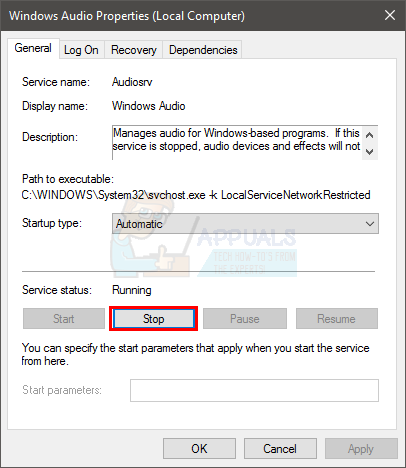
- Wait a little while. Click Start once the service is stopped.
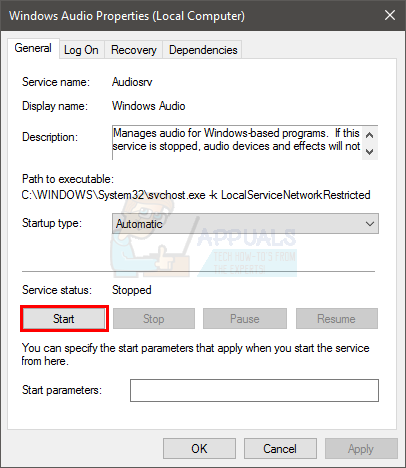
- Click Ok
Now check if the issue is solved or not.
Method 3: Roll Back Drivers
If you recently installed an updated sound drivers then that might be the culprit behind this. It isn’t uncommon that a newly released driver has a bug or compatibility issue that causes the device to misbehave. So, rolling back to the previous version will solve the issue.
- Hold Windows key and press R
- Type devmgmt.msc and press Enter
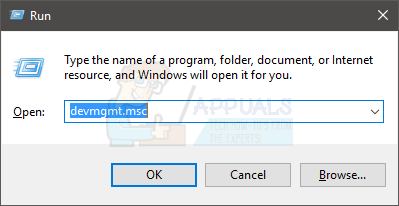
- Double click Sound, video and game controller
- Locate and double click your audio device. Note: If you see an AMD High Definition Audio Device then select that. This is because that has known to cause some issues. However, if you don’t have any AMD High Definition Audio Device then select the one that was problematic.
- Click Driver tab
- Click Roll Back Driver… and follow the on-screen instructions. Note: If the Roll Back Driver… button is greyed out then that means you can’t go back to the previous version.
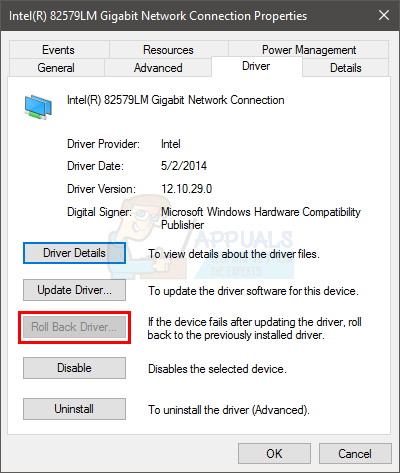
If you reverted back to the previous version, restart the computer once the process is done and check if the problem is solved or not.
Method 4: Uninstall Windows Update
Note: You should follow this step if you suspect that the problem is caused by a Windows update. If you haven’t updated your Windows for quite some time and the problem just recently started then there is no point in uninstalling the updates. Skip this method.
A lot of the times, your drivers might be updated via a Windows Update or a Windows Update might be causing this issue. If you recently installed a Windows Update then there’s a high chance that the issue will be solved by uninstalling that specific Windows Update. The update we are looking for is the Windows update KB2962407. If you have that then uninstall this Windows update and everything should be fine. If this isn’t an update you recently installed, uninstalling the ones that you just recently installed isn’t a bad idea if you are trying to troubleshoot the issue.
Note: Keep in mind that we don’t recommend uninstalling Windows Updates or not updating your Windows for this reason. If uninstalling the update solves the issue then you should wait for the next update. Microsoft does a great job at continuously releasing updates. So, hopefully, the problem will be solved in the next few updates.
Follow the steps given below to uninstall the installed updates
- Hold Windows key and press R
- Type appwiz.cpl and press Enter
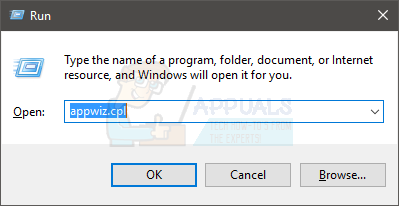
- Click View Installed Updates from the top left corner of the window

- Locate the updates that you recently installed. If you see a Windows update KB2962407 then uninstall it. Otherwise, uninstall the updates that you recently installed. Select the update and click Uninstall.
Once done, restart your system and check if the problem is solved.
Method 5: Install Windows Native Audio Drivers
If the problem is still there then it’s time to switch to the Windows own audio drivers. The good thing about Windows is that it comes with its native drivers. And, most of the time, they work pretty well mainly because they are the most compatible ones. If nothing else is working then switching to the Windows native audio drivers isn’t a bad thing.
- Hold Windows key and press R
- Type devmgmt.msc and press Enter

- Double click Sound, video and game controller
- Locate and right click your audio device driver
- Select Update Driver Software…
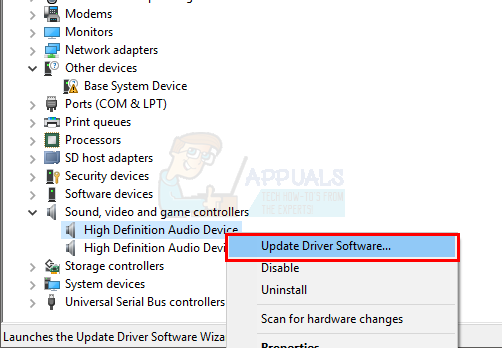
- Select Browse my computer for driver software
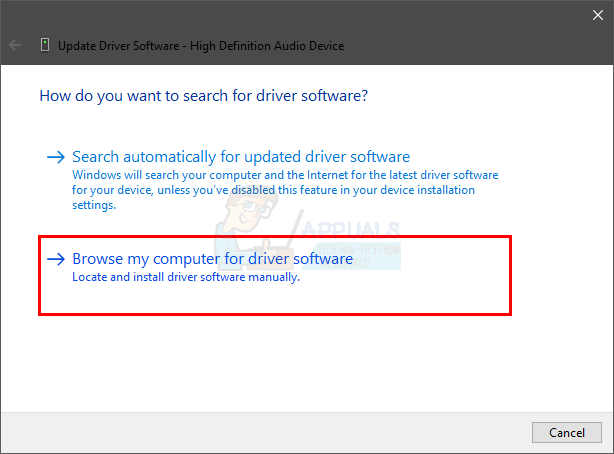
- Click Let me pick from a list of device drivers on my computer
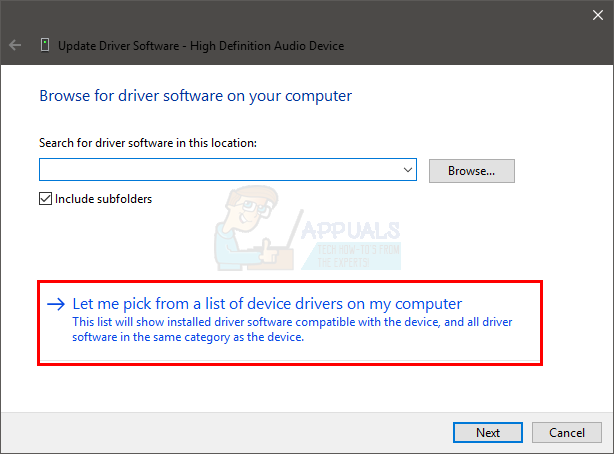
- It will show you a list of drivers available. Select High Definition Audio Device
- Click Next
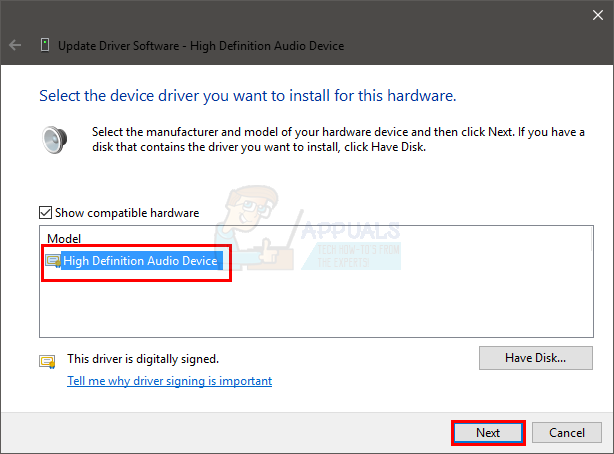
- Confirm any additional prompts
Once done, restart your computer and check if the problem is solved or not. This should definitely solve the problem if nothing else worked.
Note: If you want to go back to your audio device drivers then simply follow steps 1-7. On step 8, select your audio device drivers and click Next. Simple as that.